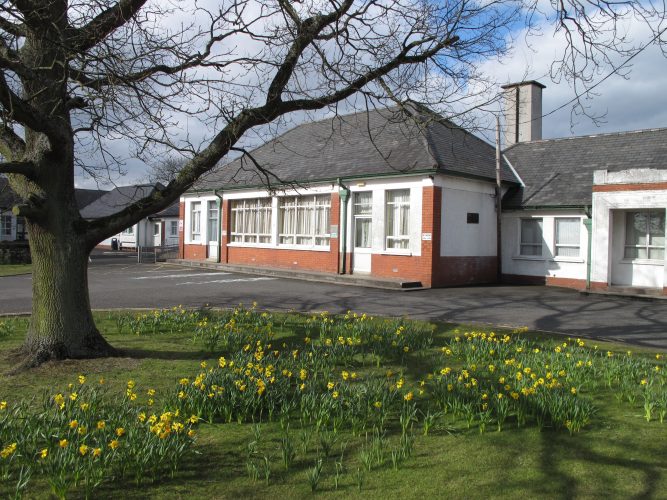4. Dalriada School

3. Coleraine
6th March 2023
5. The Dark Hedges
6th March 20234. Dalriada School
In AD 502, Fergus, son of King Erc and Prince of the Dalriada kingdom in North Antrim, with his two brothers, Lorne and Angus, crossed over and founded the kingdom of Argyle (‘the Eastern Gael’), or Scottish Dalriada, and so began the long history of Gaelic Scotland. The kings of Dalriada had their seat at Dunseverick, a few miles from Ballymoney, and through them the British Royal House traces its descent from the high kings of Ireland. Dalriada School, founded in 1878, is named in honour of this kingdom.
THE SCHOOL CALLED DALRIADA (The Early Years)
By Robert Johnston
“To work without care is to work in vain”.[1]
For at least two hundred years, Ballymoney has been a centre of education in North Antrim – the ancient Dalriada. In a laneway off Linenhall Street, there is a stone built into the wall of a store on which is the inscription, “E. S. Free School 1813”. That stone and a large bronze bell, now in use in Dalriada School, are all that remain of the old Erasmus Smith School that used to be in that vicinity. From 1878, when “Armour of Ballymoney” became the first headmaster of what was then called the Intermediate School (housed in the old Town Hall beside the Town Clock) the school has had a continuous and honourable history.
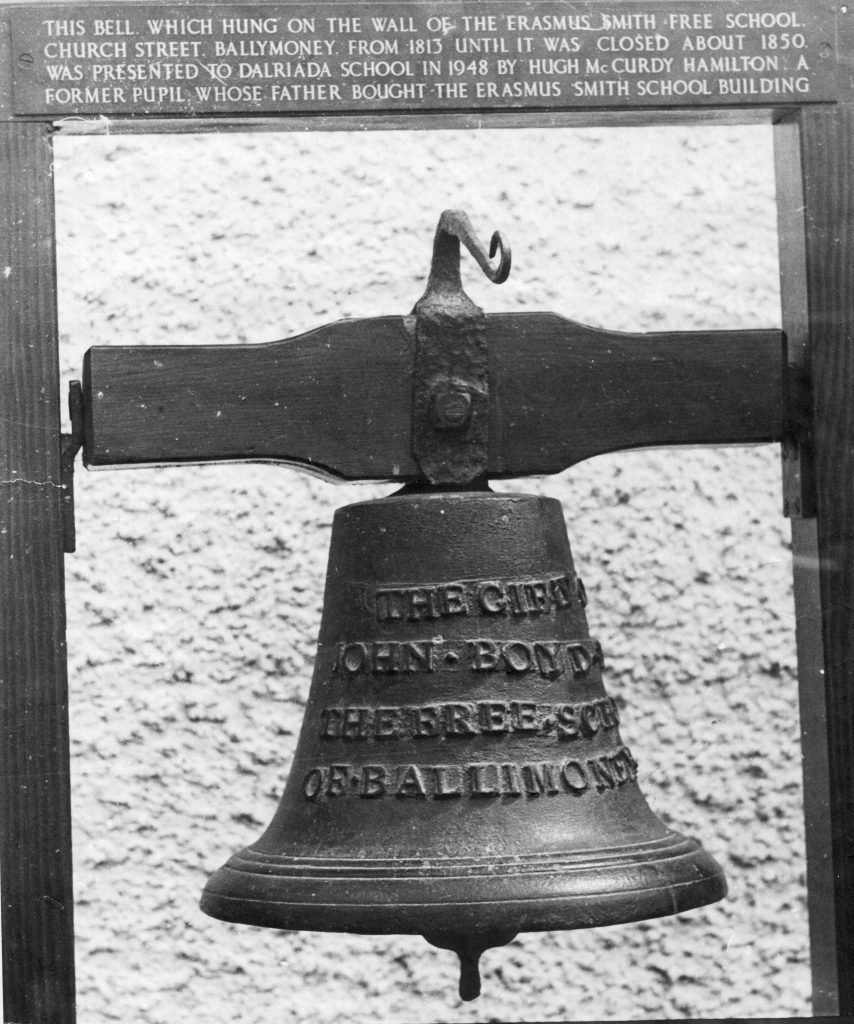
Erasamus Smith School bell.
The school has a rather special tradition of tolerance, of respect for other people’s opinions, of freedom to express one’s ideas, and of learning to live together in friendship even if we have on many subjects rather different convictions and thoughts. There is a strong emphasis on meeting and caring for individual needs together with out-of-school activities, organised through almost forty clubs and societies – sporting, cultural, enterprising and charitable, that are as crucial in the fulfilment of the school’s aims as work in the classroom. It is a school that recognises the power of education to transform young people into critical, independent thinkers, regardless of gender, ethnicity, status or denomination. That mission, founded by the Rev. James Brown Armour, M.A. (1841-1928), is now more important than ever.
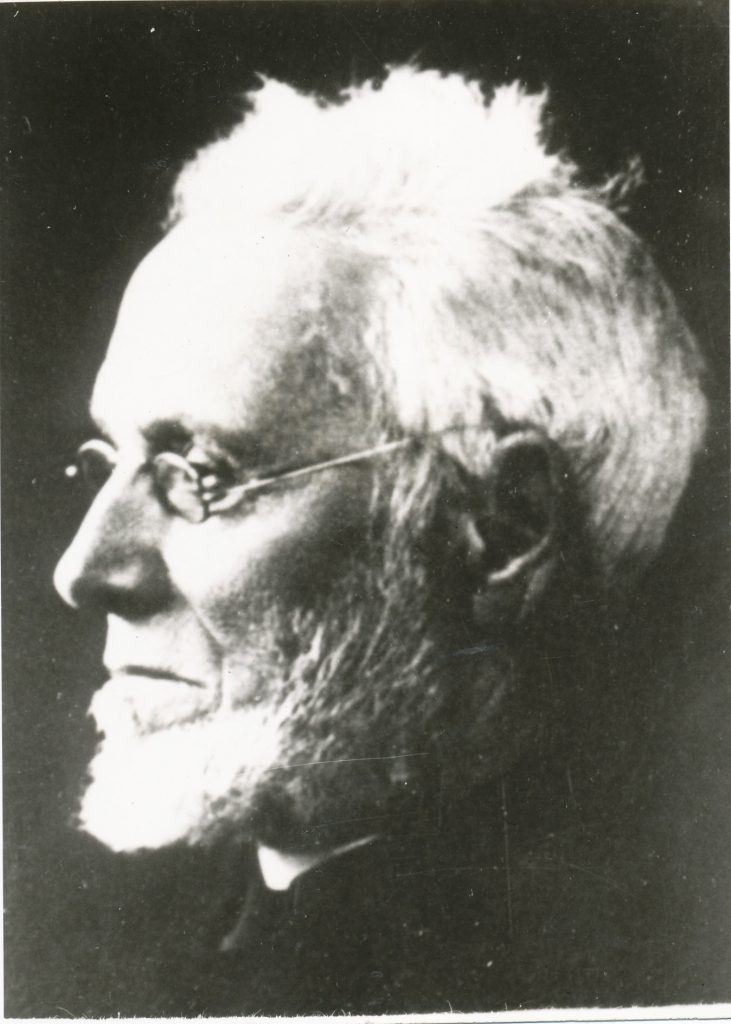
Reverend J B Armour
Two other Presbyterian ministers succeeded Armour for short periods. Then the 16-year Headship of Mr. William Beare, M.A. (Principal from 1885 to 1901) was important for the school’s development. A period in which such men and women as
- the Rev. William Brown Lusk (1869-1952) who, in February 1926, officially received the “Toc H.” Lamp of Maintenance for America from His Royal Highness the Prince of Wales in the Royal Albert Hall, London, having taken this famous movement to America after the First World War.
- Sir John W. D. Megaw, K.C.I.E., D.Sc., M.B., B.Ch. (1874-1958), Director-General of the Indian Medical Service and Honorary Physician to His Majesty King George V from 1930 to 1934
- Sara Lyle McElderry (1877-1961), Medical Practitioner and Missionary in India, and many others, made their mark on the life of the province and other parts of the world having been pupils.
The Rev. Professor John Ramsey, B.A., LL.B. (1860-1954) was Mr. Beare’s colleague during the whole of his Headship and soon after his departure for Lurgan College became joint principal with Miss Jeannie Newton McNeill, B.A. and Mr. John Christy, M.A. John Ramsey gave 62 years of service to the school as a member of staff (1885-1905), Joint Principal (1905-1917), Governor (1924-1935) and Chairman of the Governors (1935-1947). The Royal Humane Society of Canada presented him with their Sanford Gold Medal in 1892 for his heroism at Niagara Falls when he rescued a lady who had lost her footing in an accident on the girders of the suspension bridge.[2]
Men and women who later contributed much to the town and district, and beyond, as were then at the school, included Mr. Wallace McClure, Mr. J. W. Pinkerton, Rev. R. H. Wilson, Father James Boyle, Dr. Ross Thomson, Miss Mary Christy, Mrs. Annie Megaw and Lieutenant James Hart. Lieutenant Hart (1892-1918), was awarded the Military Cross for conspicuous gallantry and devotion to duty south of Bailleul on 13th April 1918. He had been an engineering student at Queen’s University, Belfast, where he took his B.Sc. and was for some time in the Officer Training Corps at the university from which he was appointed to the West Riding Regiment on 20th July 1915. He was killed in action in November 1918, aged 26, ten days before the Armistice of the First World War. Several school trips to the First World War Battlefields and Memorials in Belgium and France have taken place in recent times.
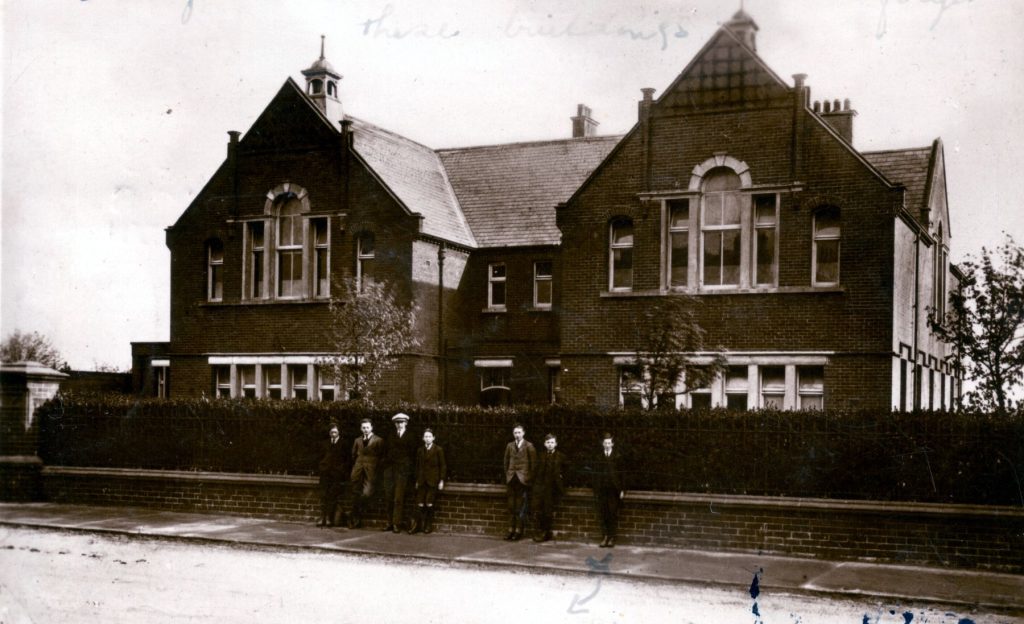
Postcard, 1926, showing Ballymoney Technical School.
Not until Mr. Beare left did the co-operation with the Technical School, whose beautiful red-brick building on Charles Street was from the outset shared by the school, begin. Pupils and teachers shared the building until the development of the day Technical School and the growth of the High School under the inspired Headship of Dr. Alfred Ross, B.Sc., Ph.D. (Headmaster 1931-1948) made a new building imperative. In 1937, Dr. Ross set up a new home for the school on St. James’s Road, and under his successors (G. E. Gordon 1948-75, A. W. Reynolds 1975-87, W. S. Calvert 1987-2003, D. C. Boyd 2003-2007 and T. J. Skelton 2007-present) the facilities of the school have been greatly extended and enhanced in response to growing numbers and the widening secondary curriculum.
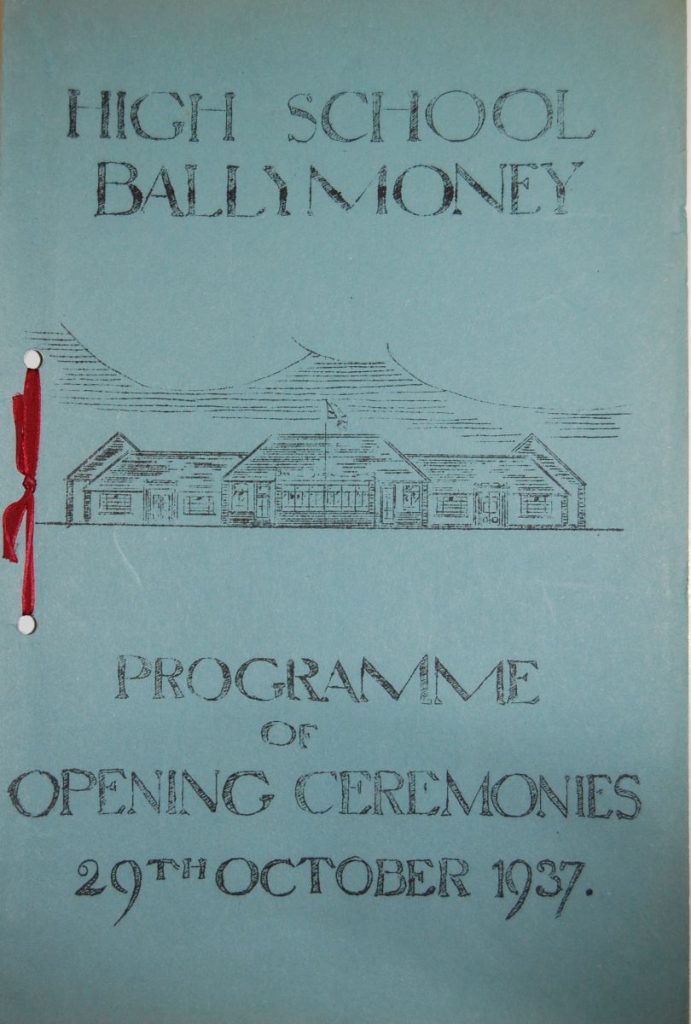
Ballymoney High School Programme of the Opening Ceremony, 29th October 1937
Truly the name Dalriada is one of which governors, parents, guardians, pupils, staff and friends of the school community are proud, and for which they are deeply grateful. During the opening ceremonies of the new building on 29th October 1937, the Headmaster, Dr. Ross announced, in introducing the play, “Dalriada”, which showed the historical importance of the ancient kingdom, that the Governors were considering a change of name from the High School to Dalriada School. Dr. Ross had prepared a detailed paper which traced the historical right for Ballymoney to use Dalriada in its school name and he gave the following reasons which influenced the Governors for making this change:
“The North Antrim region of which Ballymoney is the geographical and administrative centre is known to its inhabitants as The Route. This name is derived from the ancient name Dalriada which in historic times has contracted through the forms Riada, Reuda and Reuta to the present name. The ancient kingdom of Dalriada was of great historical importance. From it Scotland acquired the Gaelic language, Christianity, and the Stuart line of Kings from which the House of Windsor is descended. It is surely desirable that these facts should be recognised and commemorated in the administrative centre of this district.”[3]

Certificate of Change of Name from Ballymoney High School to Dalriada School
The play, after Dr. Ross’s announcement, was written by the English teacher, Mr. George Edmund Gordon, M.A., Dip. Ed. (1910-1999), later Headmaster from 1948 to 1975. “Dalriada” showed the historical importance of the ancient Kingdom in the Coronation Year of Their Majesties King George VI and Queen Elizabeth. The play was revamped by Mrs. Sharon Flynn, Mrs. Marion Hadden, and Dr. Terry Hunter, former English teachers, and restaged by pupils at ‘An Evening of Drama and Nostalgia’ during the 75th anniversary celebrations of the school on its present site at St. James’s Road in 2012. The original play ended with these words spoken by St. Olcan, Patrick’s young disciple and the first Bishop of Dalriada (played by Francis Joseph Boyle in 1937):
“I slept and saw a vision; and the name
“Dalriada” still is ringing in my ears,
As though from down the centuries. Here I sit
An old man dreaming dreams, and in my dreams
Seemeth that Fergus’ venture hath success:
Faith in Christ, a love of peace and reverence
For learning reign among the heathen British
And tribal war and ignorance be no more;
And over all these islands one king reign
And my heart sees him as of Fergus’ line
For all these things I offer thanks to God”.[4]
The play concluded with the singing of the song, “O Dalriadan Land” which has since always been sung at the end proceedings on every Prize Day and End-of-Term assembly as the School Song.
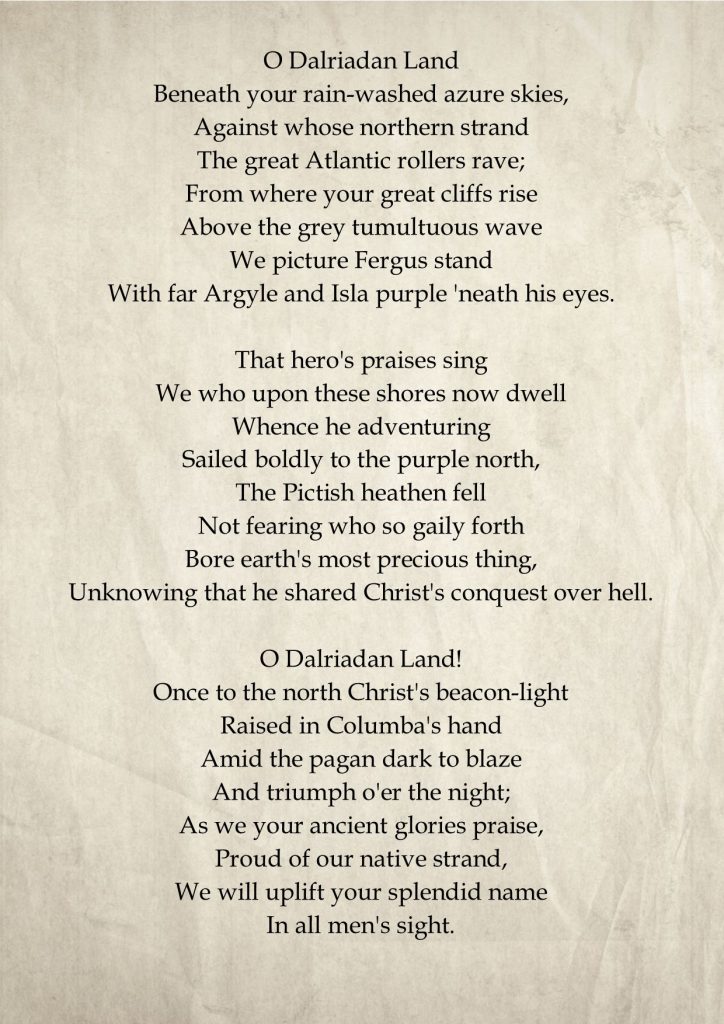
The School Song – O Dalriadan Land
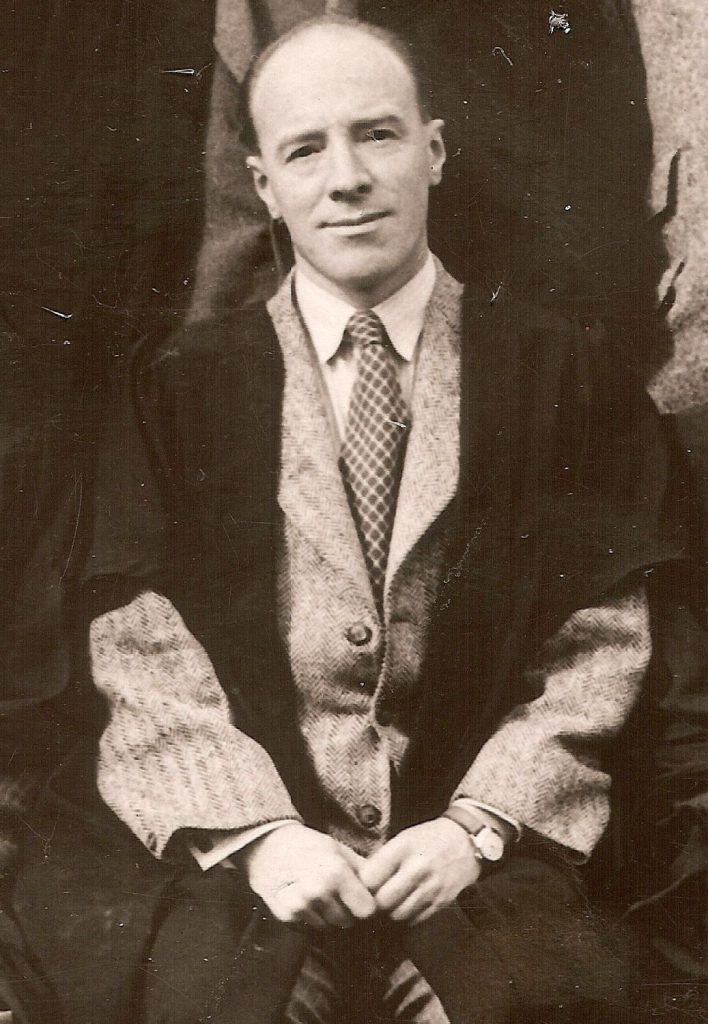
George Edmund Gordon
The School Song, written by Mr. Gordon, encapsulates what happened in 502 A.D. A royal prince set sail from a little harbour a dozen miles from Ballymoney and crossed that inlet of the Atlantic Ocean beyond which, on a clear day, one can see, from the White Rocks or the Giant’s Causeway, the island of Isla and part of the mainland of Argyle. He was a prince of the ancient Kingdom of Dalriada, and he was to become King of a new Dalriada, a colony of the old, in what was then the land of the Picts. He and his band of warriors called themselves Scots (then the name for Irish inhabitants); and from them, in later years, the whole country was to take the modern name of Scotland. The prince’s name was Fergus, and afterwards he was called King Fergus the Great. His descendants became the first kings of the whole of Scotland, and, finally, of England, too. One of them is the present King.
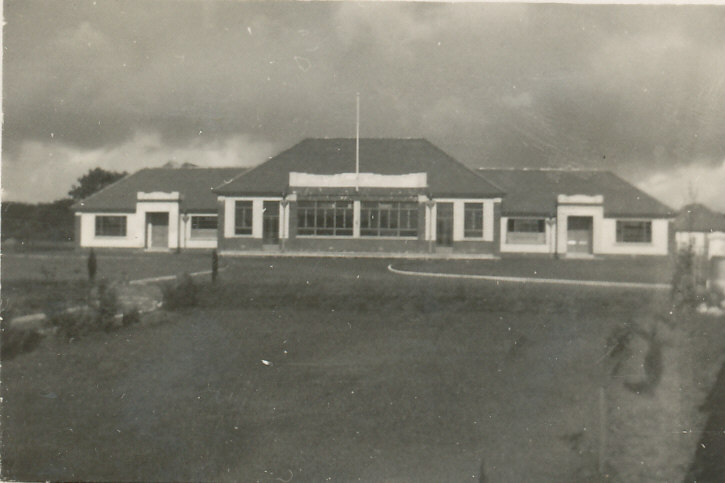
The new school, c.1937.
Following the opening of the new building in 1937 by Lady Helen Moore (the wife of Sir William Moore, the second Lord Chief Justice of Northern Ireland), His Grace the Duke of Abercorn, Governor of Northern Ireland, honoured the school by visiting it on 2nd November 1937. He planted an oak tree in the school grounds, just opposite St. James’s Presbyterian Church, to commemorate the Coronation Year of Their Majesties King George VI and Queen Elizabeth in which the new school building was erected. The bronze commemorative plaque on the boundary wall close by calls the tree the “Coronation Oak” and it is a splendid backdrop today for school photographs of pupils. A petition to His Majesty King George VI and related correspondence to the Duke of Abercorn in the school archive shows the School Governors endeavouring to style the school, ‘Royal Dalriada School’, but this petition was unsuccessful. On the 8th May 1939, Ballymoney High School officially changed its name to Dalriada School.
Two other significant landmarks in the school’s progress have been the opening of the King Fergus Wing (1958) and the John Armstrong Hall (1969).
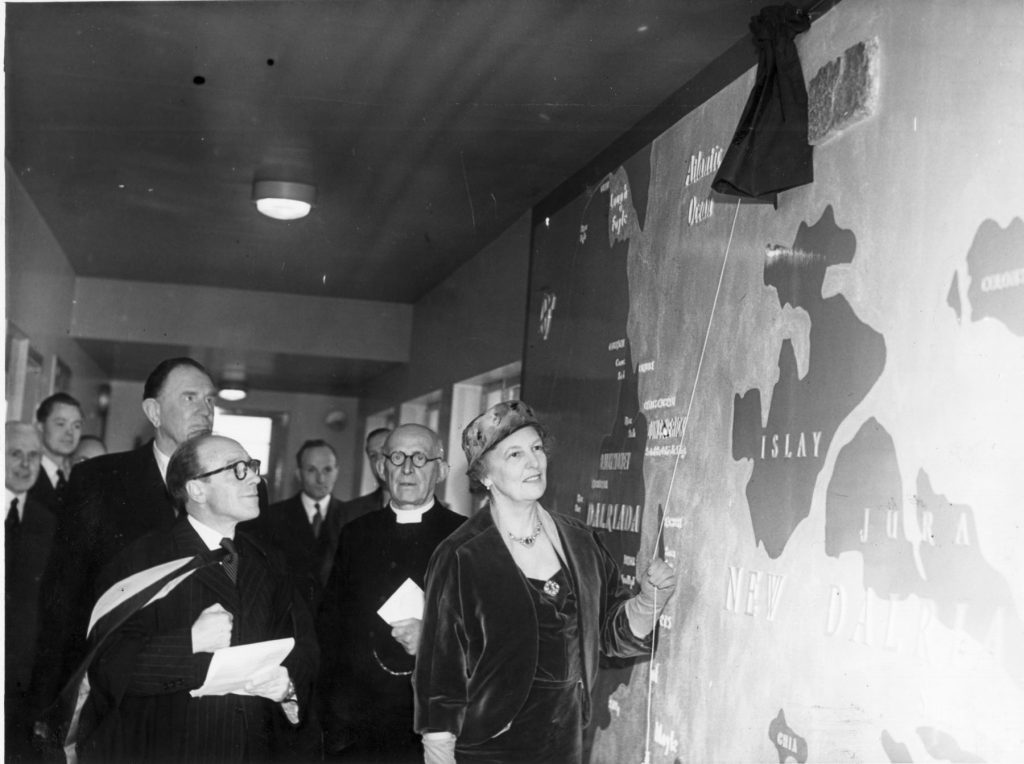
Lady Wakehurst unveiling the stone in the Fergus Wing.
The King Fergus Wing was formally opened on 9th April 1958 by the Governor of Northern Ireland, His Excellency the Lord Wakehurst, K.C.M.G. It was originally designed so that the Preparatory Department would be in one part of the school and today houses the Mathematics Department. The name of the wing commemorates Fergus Mor, the Sixth Century Prince of Dalriada, who led the first organised colony of ”Scots” from North Antrim to Argyle (“the land of the Eastern Gael”). Iona was within the boundaries of ancient Dalriada so that to the colonists from Dalriada, Scotland owes its Christianisation. This fact was commemorated by the unveiling by Lady Wakehurst of a stone from Iona Abbey, presented by the then Moderator of the Church of Scotland, Dr. George MacLeod, later Lord MacLeod of Fuinary (1895-1991). Three years earlier, in 1955, the Rev. Canon John Armstrong (Chairman of the Governors) and Mr. Gordon (Headmaster) had visited the island of Iona where they “had met Dr. George Macleod, leader of the community by a providential accident, for half an hour. Since then, the school had been in correspondence with Dr. Macleod, and he had promised to send a stone of Iona to build into the new extension of Dalriada School”.[5] The stone is built into a large mural map depicting the ancient Kingdom of the two Dalriada’s of Ireland and Scotland. The stone is a symbol of the spiritual heritage of Dalriada and the map, designed and made by governors, parents, teachers, present and former pupils and caretaking staff led by Mr. T. J. D. Lewis, Mrs. M. Q. Chartres and Mr. A. Sinclair, is strikingly “aligned from west to east”.[6] Ms. Jane Martin, Historic Environment Scotland District Visitor and Services Manager of Iona Abbey said in 2019: “What a great idea to present the map in this way as it makes far more sense to see how a community might expand”.[7] The two wings of the original 1937 building are named the Lorne Wing and the Angus Wing in honour of Fergus’s two brothers who accompanied him from North Antrim to Western Scotland.
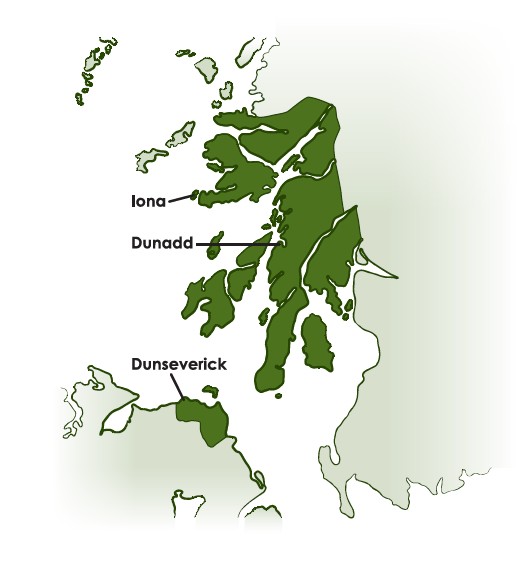
Map of the Kingdom of Dalriada
In 2012, Year 10 geography pupils and teachers mapped the ancient Dalriada kingdom for Michael Woods B.B.C. programme, The Great British Story – A People’s History. Lucy Buick, one of geographers, explained, “We visited locations around the North Coast with the BBC production crew and we all worked to map out the locations of the different islands which make up the Dalriada Kingdom. After the field task was completed we returned, with the crew, to school and produced a massive map to scale, of the Kingdom of Dalriada using large sheets of paper. It filled the floor of the large music room. Teamwork was key and we were all on our hands and knees with pencils, markers and scissors creating our own Dalriada Kingdom”.[8] In the television programme, Michael Wood, commented, “Few places show better how close the early histories and identities of Ireland and northern Britain are linked”.[9]
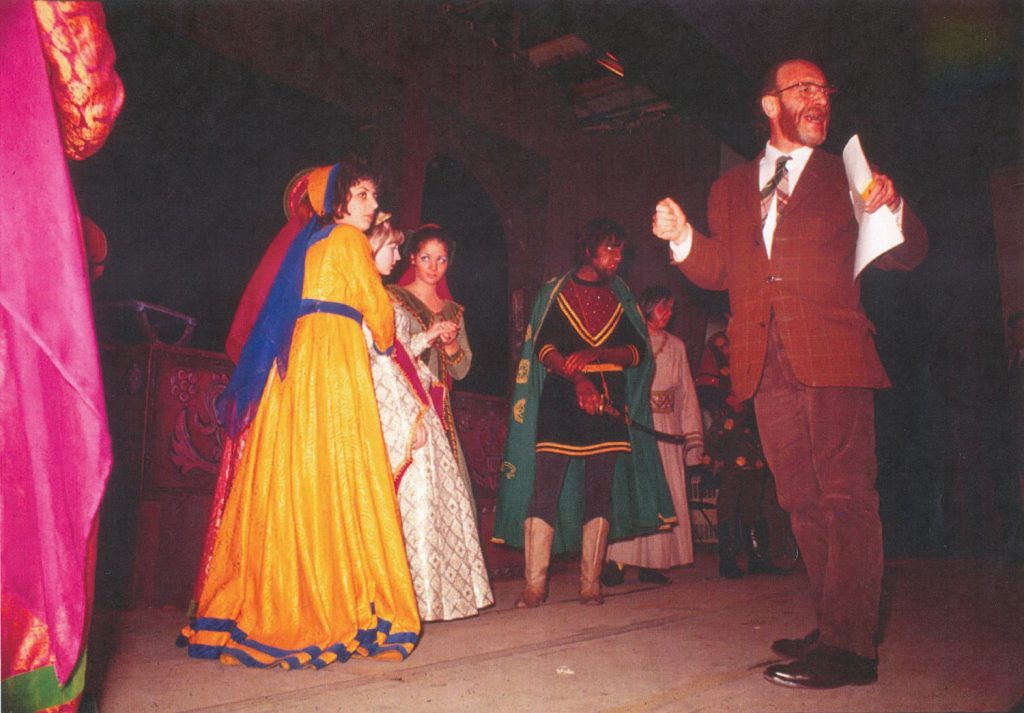
Mr Gordon directing ‘Othello’, the school play in 1970
Over seven decades, the John Armstrong Hall, with a professionally equipped stage, has been a venue for assemblies, plays, musicals, concerts, meetings, exams, conferences, shows, fairs and it was the chief physical education and games centre before the new, state-of-the art Sports Complex was opened in 2017. The Hall is named in honour of the Rev. Canon John Armstrong, M.A. (1884-1964), Rector of St. Patrick’s Parish Church, Ballymoney (1925-1959) and a member of the Board of Dalriada School’s Governors for 36 years and Chairman from 1947 until his death in 1964.
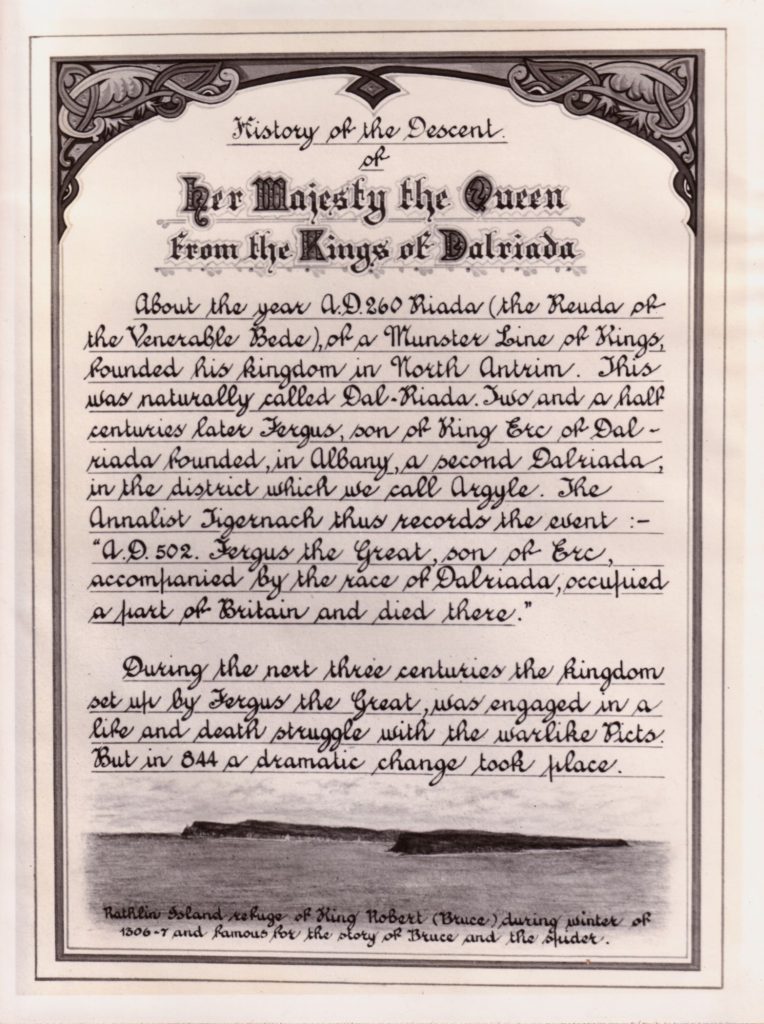
First page of ‘The Queen’s Book’.
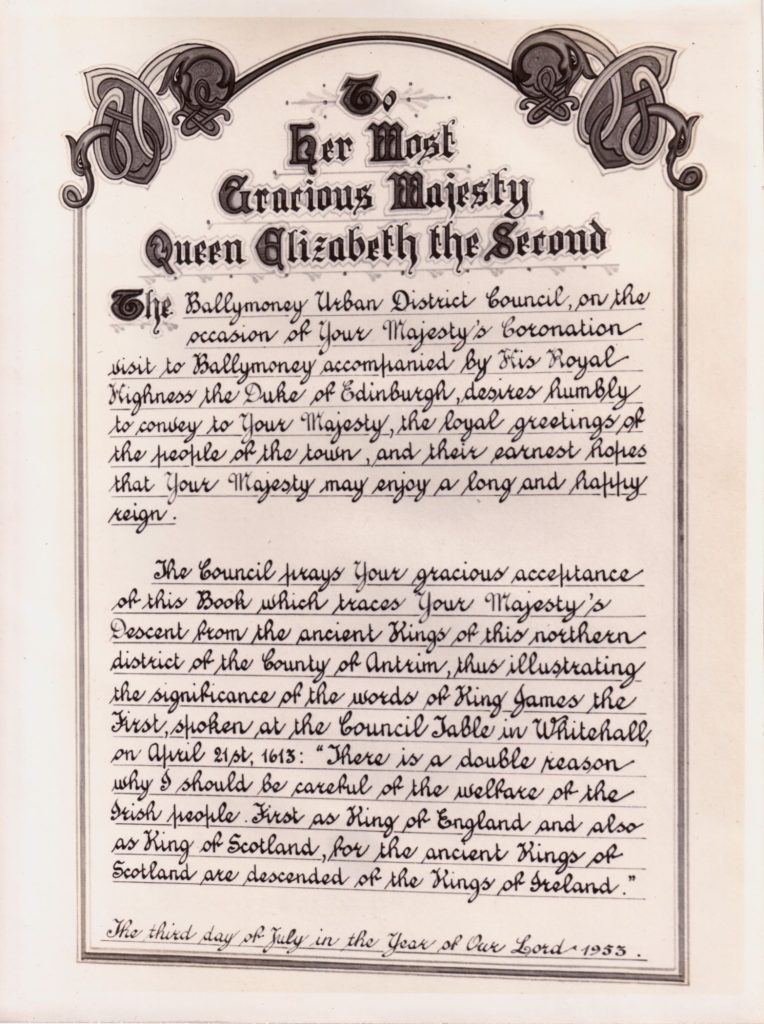
Second page of ‘The Queen’s Book’
John Armstrong was the author of The Queen’s Book presented to Her Majesty Queen Elizabeth II in Ballymoney during her Coronation State Visit to Northern Ireland in 1953. He explained that he came upon the story as a result of his study of St. Columba, “a man of great stature who was related to the Kings of Dalriada, and whose going to Scotland really laid the foundations of Scottish history”.[10] This beautiful, bound volume in red Morocco leather with gilt lines and edges has illuminated pages conveying the loyal greetings of the people of the town. It also contains water colour paintings of Rathlin Island and the ruins of Dunseverick Castle, and a coloured illustration of Ballymoney old church tower, which dates from 1637.
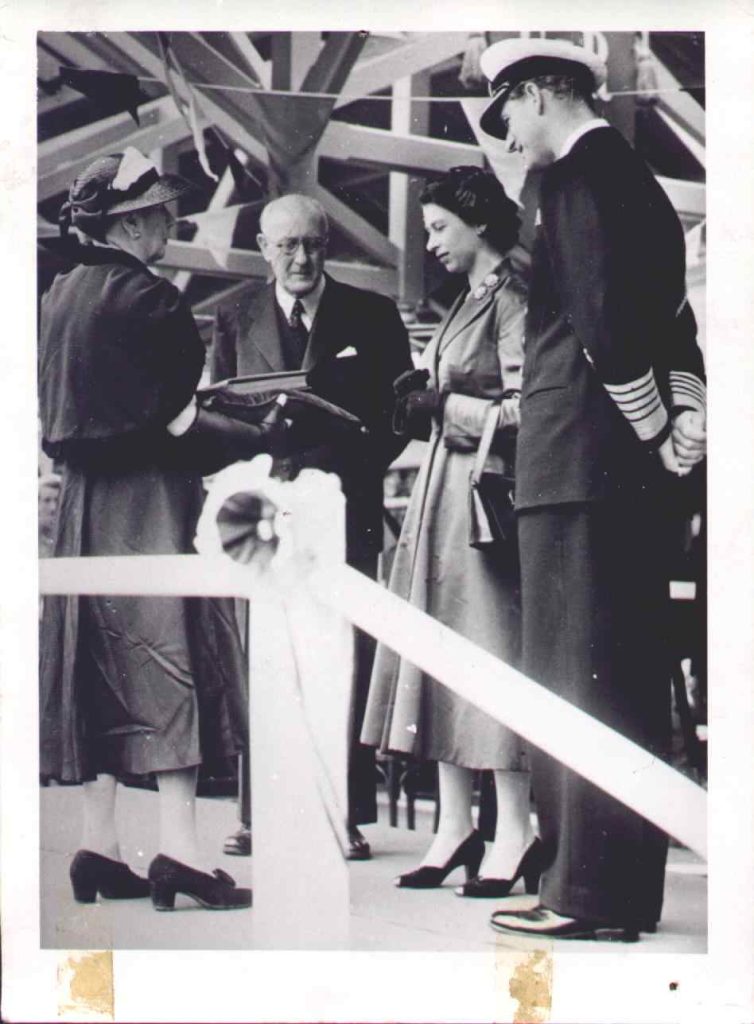
Mrs Leslie presenting Queen Elizabeth II with ‘The Queen’s Book’ in July 1953.
The book sets out the descent of the Queen from the Kings of Dalriada and was presented to the Queen by Mrs. Grace Leslie of Leslie Hill, Ballymoney. “Although Her Majesty Queen Elizabeth II’s visit to Ballymoney was during the school holidays almost the entire school assembled and marched to Ballymoney Train Station to take part in the enthusiastic reception which was given to Her Majesty” and “Dalriada School was greatly honoured when the Rev. Canon John Armstrong was presented, as Chairman of the Board of Governors of Dalriada School, to the Queen and the Duke of Edinburgh at the Garden Party at Stormont in July 1953” reported the school magazine.[11]
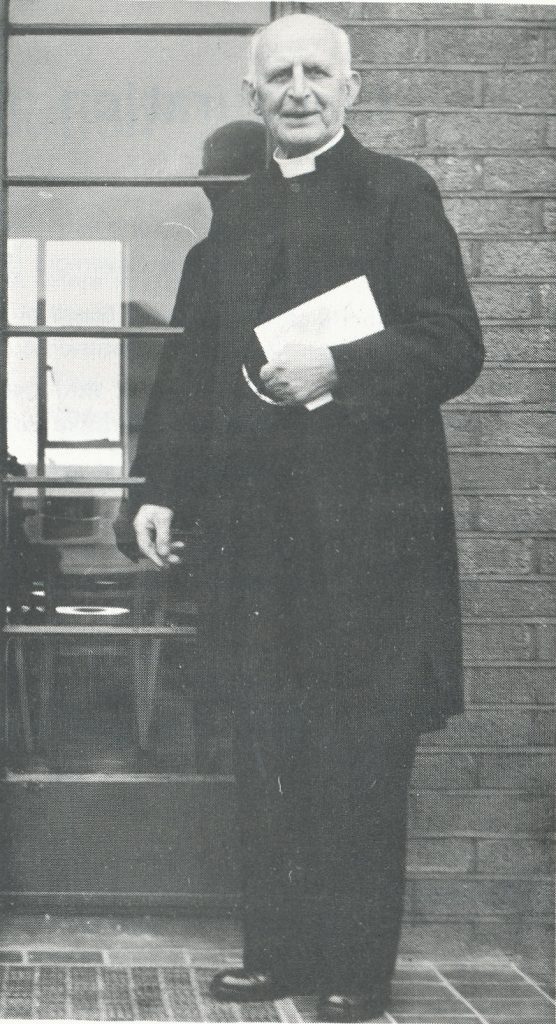
Reverend Canon John Armstrong
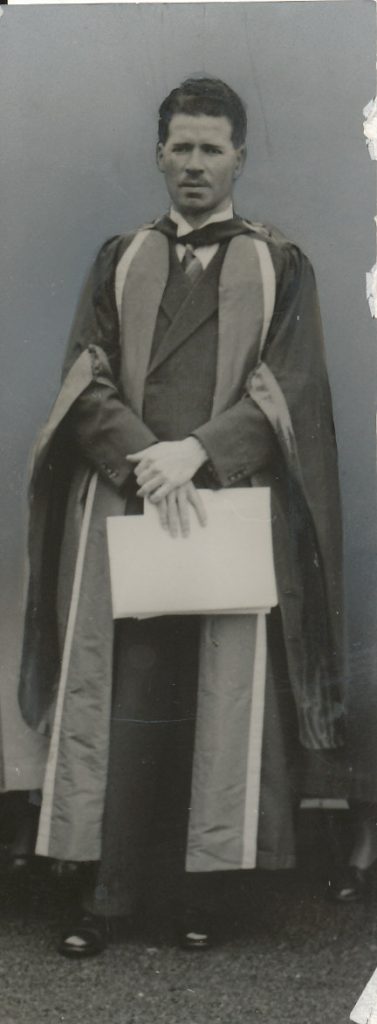
Dr. Alfred Ross
John Armstrong was closely concerned with the reorganisation of the school in 1930-31, along with Dr. Alfred Ross who was appointed Headmaster in 1931. As his obituary in the school magazine says, “John Armstrong became convinced, when powerful forces were at work to send Grammar School pupils in Ballymoney, to Coleraine and Ballymena, that it was essential to maintain a Grammar School in Ballymoney for the Route District. He devoted his great gifts in 1935-36 to the task of supporting Dr. Ross in obtaining a new building for the school. When this was achieved, as the historian of Dalriada, he convinced his fellow Governors and the Headmaster that it should be called Dalriada School. Without his efforts, the school would in all probability have ceased to exist. He became its second founder”.[12] Another obituary states, “His study of the historical significance of the ancient North Antrim kingdom of Dalriada has made a great impact on the Route District. Through him a renewed pride has been engendered in the great past of this Scottish Celtic kingdom, and in the connection with it of St. Columba and St. Patrick”.[13]
St. Patrick’s famous prophecy to the young Fergus, “Though your brother has not much respect for you today it is you who shall be king. The Kings of this country and over Fortrenn (Scotland) shall be from you forever”[14] is depicted in a more tangible form through the statuette called “Patrick and Fergus”. It was designed and made by Belfast-born painter and sculptor, David Crone, R.H.A., R.U.A. (1937-), former Reader in Painting and Head of Fine and Applied Art, University of Ulster, and accomplished Royal Hibernian Academician painter. The statuette was given to Mr. Gordon in 1975, as a retirement present in recognition of his 44 years’ service to the school. Bequeathed by Mr. Gordon to Dalriada following his death in 1999, it is now on display in the Principal’s Office. There is also another impressive artwork in School by David Crone – a large wall plaque, unveiled by Mr. Gordon in December 1975 when he opened the Edmund Gordon Centre which accommodates the English & Drama and Art & Design Departments. In ceramic material, it features in relief at its centre, figures of Patrick and Fergus, similar to those in the original statuette. Having made a special study of St. Patrick and his close associations with the ancient kingdom of Dalriada, Mr. Gordon gave several St. Patrick’s Day talks on the radio, and with his brilliant intellect and “un-subjugated thinking”,[15] astutely described Patrick, in poetic form, as “the alien youth, the displaced person of western war, the expatriated prisoner of war’s piracy, the slave behind the iron curtain of mid Antrim hills who was yet throned on the high Tower of Slemish”.[16]
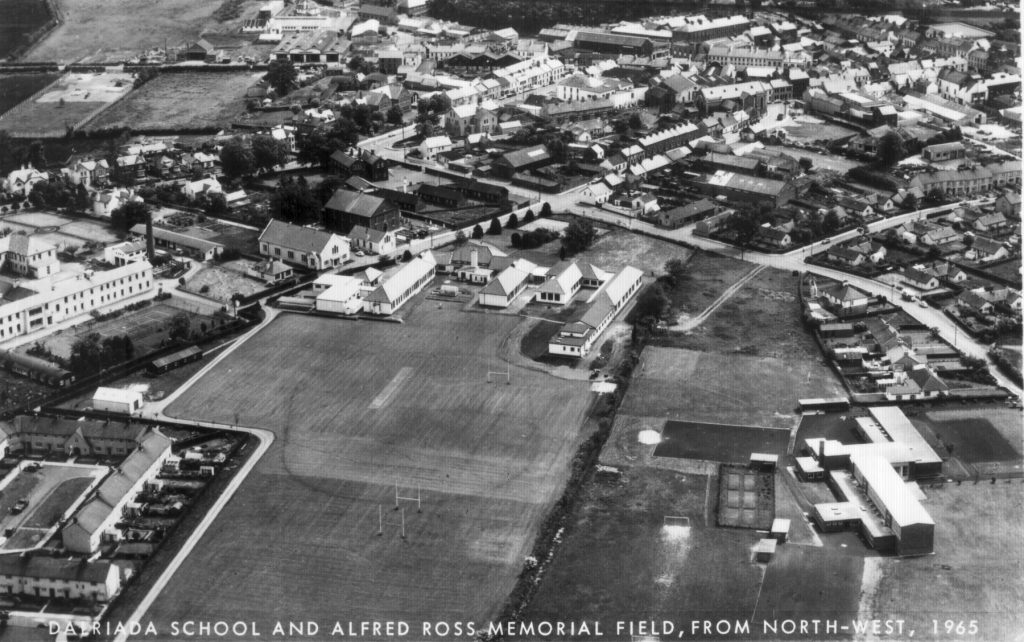
Aerial photograph of Dalriada School and the Alfred Ross Memorial Sport’s Field taken in 1965.
The early history of how the school came to be called Dalriada together with the worthy efforts of such individuals as John Ramsey, John Armstrong, Alfred Ross and Edmund Gordon, George Benington and Samuel Peden underpin the shared and unifying heritage and brings it into perspective. The bronze commemorative wall plaques in school to these six men are not merely two-dimensional representations on a wall, they are an inspiration and encouragement to everyone in the school community in the 21st century. Fifteen hundred centuries on from King Fergus the Great, you cannot walk around this school today and not be reminded of this heritage. All the historical links, with which the school is so full are very valuable in building up a background and identity in the lives and characters of the pupils. Such things become interwoven in their lives and are never forgotten. Pupils have had the opportunity to explore through the History and English Departments how history and legacy has affected their personal identity, culture and lifestyle. Part of the diversity and inclusion strand of the curriculum deals with personal and school identity. Pupils have an extraordinary identity with the Kingdom and the School. Like the ancient Irish ‘Scots’ who colonized and ruled the new Scottish Dalriada, the pupils of Dalriada School are proud to be known as ‘Dalriads’ and “to go to a place where for seven years you have the chance to soak up a set of unique indelible shared values which dye the character of the Dalriad as surely as the royal blue and maroon dyes the blazer or the scarf”[17] as one former pupil reminisced. In their achievements, Dalriads are found fulfilling vital and useful roles in the professions and business all over the United Kingdom, and indeed throughout the world. So, the venturesome and exploring spirit of Patrick, Fergus and Columba is very much alive today and Dalriads are proud of their “native strand”[18] from which has emanated an influence of worldwide importance with many ‘Royal Connections’.
These rather disconnected paragraphs on the early history of the school are written simply to suggest that the district and school abounds with historical interest. It is hoped that someday present-day pupils will draw on this narrative and present a series of short videos or a movie for the heritage trail project to further highlight the ‘Royal Connections’ of the Kingdom and the School called Dalriada.
[1] The Ballymoney High School Magazine, No. 1, 1932-33, “The School Crest”.
[2] The Royal Magazine, Volume II, May to October, 1899, pp.292-293, “Adventures at Niagara Falls” by F. A. Acland, C. Arthur Pearson Ltd., London.
[3] Ross, A., 28th December 1938, Letter from the Headmaster to Members of the High School Association.
[4] Gordon, G. E., 1937, “Dalriada: A presentation of the importance of the district of The Route in British History written for the Opening of the new High School building, Ballymoney, in the year of the Coronation of King George VI”.
[5] Gordon, G. E., 1955, Headmaster’s speech on Speech Day 1955 printed in The Dalriad, the magazine of the pupils of Dalriada School, Vol. VI, No. 3, 1956.
[6] Burgess, M. J., 5th October 2020 (former Iona Abbey Steward, Historic Environment Scotland).
[7] Martin, J., 2019 (Historic Environment Scotland District Visitor Services Manager, Iona and West Commercial and Tourism).
[8] Buick, L., 2012, The Dalriad, “BBC The Great British Story – A People’s History”.
[9] Wood, M., 2012, “The Great British Story – A People’s History”, BBC 2 series, MayaVision International.
[10] Armstrong, J. T., 1953, “Ballymoney conveys greetings in bound volume”, Northern Whig, Saturday, July 4, 1953.
[11] The Dalriad, the magazine of the pupils of Dalriada School, Vol. V, No. 2, 1953, “The Coronation”.[12] The Dalriad, Volume VIII, No. 4, 1965, “Obituary: Rev. Canon J. T. Armstrong, M.A.”
[13] Northern Constitution, June 13, 1964.
[14] Stokes, W. “The Tripartite Life of Saint Patrick”, Cambridge University Press, 2012.
[15] Robb, D., 2016, “From the Archive” Facebook Group (Head Prefect 1989-90 and Cardiothoracic Surgeon, Christiana Hospital, Newark, Delaware, United States).
[16] Gordon, G. E., 1953, “Wind Over Slemish: Verses for Patrick”, Borestone Mountain Poetry Awards1953: A Compilation of Original Poetry Published in Magazines of the English-Speaking World in 1952, University of Pennsylvania, Philadelphia. Moore, Robert T. (Editor).
[17] Warnock, S. G., 1990, Chief Guest on Dalriada School’s Speech Day and Prize Distribution, 25th September 1990 (former pupil of the School and former Director of European Community Services for the PA Consulting Group).
[18] Gordon, G. E., 1937, “O Dalriadan Land” (Dalriada School Song).
Directions
Please Note: This is a working school and there is strictly no access to either the school grounds or buildings.
Co-ordinates: 55.0728, -6.5209 (nearest public access)
This project is receiving financial support via the District Council Good Relations Programme.


